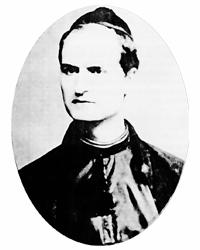<Back to Index>
- Linguist and Writer Juan Antonio Saco y Acre, 1835
PAGE SPONSOR

Juan Antonio Saco y Acre, born in Alongos on 8 March 1835 and died in Santiago de Compostela (SC) on September 14, 1881, was a linguist and writer, author of the first Galician grammar.
He studies in the ecclesiastical seminary in SC, and later studied Philosophy and Theology in SC. He held the chair of Greek language in high school institutes of Pontevedra , SC, and then Castellón de la Plana. In 1863 he took possession of the chair in the same area at the SC Institute, as a professor of Greek and then Rhetoric and Poetics.
With the advent of the Glorious Revolution, he encountered difficulties, because, along with colleagues, he refused to swear to the new constitution. But in 1873, he was reinstituted to his position. He died eight years later.
In 1868 he published the first Galician grammar in Lugo. Four years before that, another Galician grammar had been published in Santiago, entitled Compendium of Grammar Galician Castellana, but because of its poor quality and incompleteness, Saco's could be described as the first such work.
Saco also wrote poetry and published in 1878 in Ourense, Poetry, a volume of just over 400 pages, of which only nine poems are written in English and most in Spanish. Six of them are original poetry, and three translations of the Latin; all of a religious nature. The subject was new in the Galician literature.
Apart from these two works, he published a short article, Contemporary Galician poetry: its most common defects, in a newspaper in Ourense in1876 .
He had a great interest in popular literature, making use of it in order to illustrate certain passages of his Galician grammar, as well as to draw a good selection of sayings in an appendix. In 1881, before his death, he began to publish some of the materials collected under the title of Galician People's Literature, work that was interrupted. Some of the materials collected appeared dispersed in the popular song book Galician by Jose Perez Ballesteros. Part of the material that remained unpublished was later published in the Bulletin of the Commission of Monuments of Ourense province between1910 and 1929 and more in 1939.